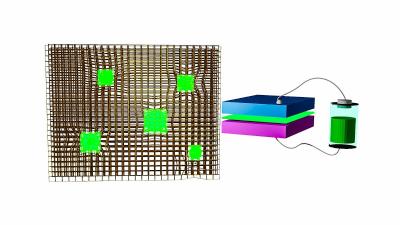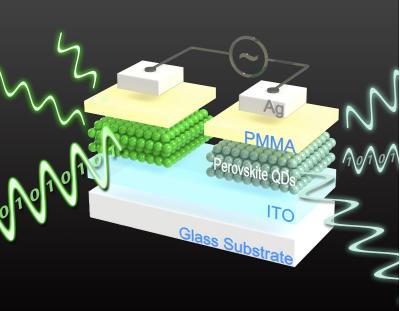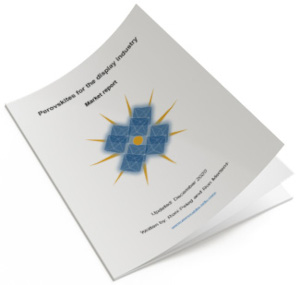Perovskite LED - Page 8
The Perovskite for Displays Market Report updated to October 2021
Perovskite-Info is proud to announce an update to our Perovskite for the Display Industry Market Report. This market report, brought to you by the world's leading perovskite and OLED industry experts, is a comprehensive guide to next-generation perovskite-based solutions for the display industry that enable efficient, low cost and high-quality display devices. The report is now updated to October 2021.
Reading this report, you'll learn all about:
- Perovskite materials and their properties
- Perovskite applications in the display industry
- Perovskite QDs for color conversion
- Prominent perovskite display related research activities
The report also provides a list of perovskite display companies, datasheets and brochures of pQD film solutions, an introduction to perovskite materials and processes, an introduction to emerging display technologies and more.
Researchers develop an architecture for efficient perovskite LEDs with improved longevity
Scientists from the Soochow University (Suzhou), the Chinese Academy of Sciences, East China Normal University (Shanghai) and Ural Federal University have developed an architecture of red-emitting perovskite LEDs (PeLEDs) that minimizes optical energy loss and significantly increases their efficiency and longevity.
The new work may open the door to high-performance LEDs for lighting devices, displays and other electronic devices. These could be energy efficient and at the same time have high brightness and long operating time.
Researchers stabilize perovskites in MOFs for use in LEDs
Researchers from the U.S. Department of Energy's (DoE) Argonne National Laboratory, Brookhaven National Laboratory, Los Alamos National Laboratory, SLAC National Accelerator Laboratory and Taiwan's Academia Sinica have reported the preparation of stable perovskite nanocrystals for LEDs.
 Light-emitting diodes made from perovskite nanocrystals (green) embedded in a metal-organic framework. Image from Phys.org
Light-emitting diodes made from perovskite nanocrystals (green) embedded in a metal-organic framework. Image from Phys.org
Perovskite nanocrystals' unstable nature has so far hindered their potential to be used as LED materials. However, the research team managed to stabilize the nanocrystals in a porous structure called a metal-organic framework, or MOF for short. Based on earth-abundant materials and fabricated at room temperature, these LEDs could one day enable lower cost TVs and consumer electronics, as well as better gamma-ray imaging devices and even self-powered X-ray detectors with applications in medicine, security scanning and scientific research.
Researchers examine the potential of perovskites for next-gen LED-based data communications
Researchers from the University of Surrey and the University of Cambridge have examined how two semiconducting materials can satisfy the telecommunication industry's hunger for huge amounts of data at increasing speeds. Light-emitting diode (LED)-based communications techniques allow computing devices, including mobile phones, to communicate with one another by using infrared light. However, LED techniques are underused because in its current state LED transmits data at far slower speeds than other wireless technologies such as light-fidelity (Li-Fi).
The researchers from Surrey and Cambridge, along with partners from the University of Electronic Science and Technology of China, examine how organic semiconductors, colloidal quantum dots (CQDs) and metal halide perovskites, can be used in LED-based optical communications systems.
Perovskites enable novel light-emitting memory devices
Researchers from National Taiwan Normal University and Kyushu University have developed a new memory device, readable through both electrical and optical methods, that needs only perovskites to simultaneously store and visually transmit data.
 Schematic of the CsPbBr3 QD-based LEM device. Image from Nature Communications
Schematic of the CsPbBr3 QD-based LEM device. Image from Nature Communications
By integrating a light-emitting electrochemical cell with a resistive random-access memory that are both based on perovskite, the team achieved parallel and synchronous reading of data both electrically and optically in a 'light-emitting memory.'
Tip-induced strain engineering of single metal halide perovskite quantum dots
A joint research team, affiliated with Korea's UNIST, has developed a novel method capable of controlling the brightness and wavelength of quantum dots (QDs). The work was led by Professor Kyoung-Duck Park in the Department of Physics at UNIST, in collaboration with Professor Sohee Jeong in the Department of Energy Science from Sungkyunkwan University (SKKU).
The research team demonstrated the tip-induced dynamic control of strain, bandgap, and quantum yield of single CsPbBrxI3'x pQDs by using a controllable plasmonic nanocavity combined with tip-enhanced photoluminescence (TEPL) spectroscopy.
Researchers design efficient germanium-lead perovskite LEDs
A research team, led by Prof. Di Dawei from the Zhejiang University College of Optical Science and Engineering, recently discovered that by using germanium (Ge), an environmentally friendly group-IV element, to partially substitute lead in the perovskite, it is possible to create highly luminescent perovskite materials and devices.
 Schematic of the Ge'Pb PeLED device structure. Image from Nature Communications
Schematic of the Ge'Pb PeLED device structure. Image from Nature Communications
To resolve the toxicity problem that arises from the use of lead, an effective method has been the use of tin (Sn) as a partial or full replacement of lead in the perovskite materials. This strategy has been particularly successful for perovskite solar cells. However, tin-based (including tin-lead) perovskite materials are generally very poor light emitters, causing unsatisfactory performance of tin-based perovskite light-emitting devices (LEDs).
New functional materials combine the advantages of 2D materials and hybrid perovskites
A team of researchers from the universities of Marburg, Giessen and Paderborn has combined the advantages of two-dimensional materials and hybrid perovskites, to create new materials to benefit computer chips, light-emitting diodes and solar cells.
The team explains that the development of new two-dimensional materials has, to date, been rather limited to structures with layers of rigid chemical bonds in two spatial directions - like a sheet of paper in a stack. Now, for the first time, the research team led by Dr. Johanna Heine (Inorganic Chemistry, Philipps University of Marburg) has overcome this limitation by using an innovative concept. The researchers developed an organic-inorganic hybrid crystal which consists of chains in a single direction, yet still forms two-dimensional layers in spite of this. This makes it possible to combine different material components, like pieces in a construction set, to create tailored materials with innovative properties.
AMOLF researchers create new ion exchange lithography technique
AMOLF researchers Lukas Helmbrecht and Wim Noorduin have developed a reactive ink that can be painted on an equally reactive canvas. The ink reacts with the material on the canvas to become a semiconductor that emits colored light, an essential part of electronic components such as LEDs.
 Schematic illustration showing the fabrication of a spatially patterned perovskite film. Image from Advanced Materials
Schematic illustration showing the fabrication of a spatially patterned perovskite film. Image from Advanced Materials
The AMOLF team's new ion exchange lithography technique enables one to paint a canvas by making the canvas itself change to a different color instead of brushing paint on it. In this technique, the 'ink' reacts with the 'canvas' by means of ion exchange. To demonstrate the technique, the team used it to airbrush an image of Madame Curie. 'I find it fascinating to see: the green image forms as soon as you start spraying, despite both the ink and the canvas being colorless', said Helmbrecht.
The Perovskite for Displays Market Report updated to April 2021
Perovskite-Info is proud to announce an update to our Perovskite for the Display Industry Market Report. This market report, brought to you by the world's leading perovskite and OLED industry experts, is a comprehensive guide to next-generation perovskite-based solutions for the display industry that enable efficient, low cost and high-quality display devices. The report is now updated to April 2021.
Reading this report, you'll learn all about:
- Perovskite materials and their properties
- Perovskite applications in the display industry
- Perovskite QDs for color conversion
- Prominent perovskite display related research activities
The report also provides a list of perovskite display companies, datasheets and brochures of pQD film solutions, an introduction to perovskite materials and processes, an introduction to emerging display technologies and more.
Pagination
- Previous page
- Page 8
- Next page




